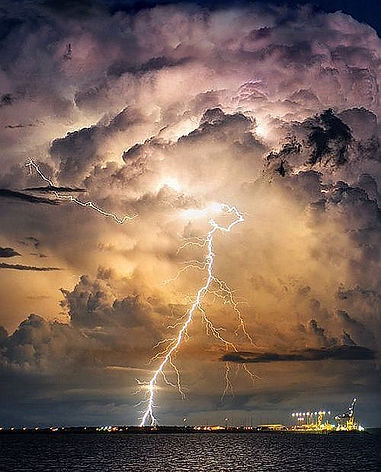Dealing with storm damage roof repair can be a real challenge. It comes in all sorts of forms, from the obvious, like a tree crashing down, to the less noticeable, such as missing shingles from hail. No matter the type of damage, it's tough to figure out what steps to take.
What Kind of Damage Should I Watch Out for After a Storm?
Storms can lead to various types of damage, including wind, hail, water, and impact damage.
Wind Damage
Strong gusts of air can get underneath your roof, potentially loosening or detaching roof tiles. Signs of wind damage may include missing deck boards and torn underlayment.
Hail Damage
After a storm, check for hail damage. Large hailstones can leave dents on roofing material and gutters. Some areas may also experience leaks if the stones perforated or cracked the surface.
Water Damage
Storms commonly result in water damage. Look out for ceiling stains or discolouration as indicators of this problem. Additional signs include mold on walls and ceilings, roof leakages, sagging or bulging ceilings, and spongy wood decking.
Impact Damage
During a storm, large objects like stones or tree branches can fall on the roof, causing impact damage. Watch for dents, cracks, and roof sagging. Additionally, inspect the perimeter of your foundation for pieces of broken roofing material.
What Should You Do If Your Roof Has Storm Damage?
- Check the Damage, Take Pictures: Once the storm settles and it's safe to head outside, take a good look at your roof. Snap photos and videos to document the damage—keep an eye out for missing shingles, messed-up gutters, or any obvious signs of trouble.
- Reach Out to Your Roofer: Your go-to person right after a storm should be your local roofing contractor. Give them a call pronto. They'll check out the damage and guide you on whether filing an insurance claim is necessary, considering your policy deductible.
- Contact Your Insurance Company: Next in line is a call to your insurance provider. Remember, paperwork is key here. Stay organized by taking photos and holding onto receipts for any quick fixes you make before the insurance rep shows up. Typically, your homeowner's insurance covers weather-related damage (think snow, hail, wind, fire) and sudden mishaps (like burst water pipes). But keep in mind that natural disasters like floods and earthquakes might need a separate policy.
- Swift Storm Damage Roof Repair are Crucial: Don't drag your feet on storm damage roof repair. Delaying fixes can lead to more water damage and potential health issues for your family. Moisture creeping into your home is a breeding ground for mold and mildew. Schedule those storm damage roof repairs ASAP to prevent further damage and health risks.
Choose a seasoned roofer who's familiar with storm damage—they can guide you through the insurance claim process or handle emergency restoration covered by roofing warranties. Steer clear of storm chasers!
Opt for a reliable local roofing contractor who'll get the job done right the first time. Once your insurance claim gets the green light, have your roofer replace your roof without unnecessary delays.
How Much Does It Cost To Get Storm Damage Roof Repair?
Fixing roof damage comes with a range of costs and time frames. Small repairs, like replacing a few shingles, might set you back a couple of hundred dollars and just a few hours of work. But when we're talking major damage, brace yourself for a substantial bill and a longer storm damage roof repair timeline.
The price tag isn't just about the roof itself – it's about safeguarding everything underneath. A damaged roof can wreak havoc on the framing, drywall, electrical systems, and flooring. I've seen cases where falling trees not only wrecked the roof but caused extensive damage to these vital home components. The storm damage roof repair bill for such scenarios easily climbs into the tens of thousands of dollars. The silver lining? Whole trees crashing into houses is, fortunately, a rare event.
For most homeowners, storm damage tends to lean towards things like damaged shingles, gutters, or maybe a small hole. The good news is, these issues are usually manageable and won't require major structural work or a full roof replacement that skyrockets your storm damage roof repair costs.
How To Prevent Future Roof Damage from Storms
Shielding your home from nature's unpredictability isn't foolproof, but you can take some simple precautions. A well-kept roof is your best bet for maximum protection. While there isn't a strict schedule for roof inspections (they're not an everyday thing), it's crucial to get them as needed.
If you suspect something's amiss with your roof, don't hesitate to schedule an inspection. It's a smart move to get one towards the end of your roofing material's life, be it shingles, shakes, or tiles. A professional can provide expert insight into how much life your roof has left and when it's time to think about a replacement. They'll also check the underlying structure to make sure it's in good shape.
Now, let's talk about trees – the big players in roof threats. Sure, they offer lovely shade (and sometimes a bit of moss and lichen), but they come with risks. I'm not saying you need to chop down all your trees, but it's a risk-reward situation every homeowner faces.
Choose a Reliable Roofing Contractor
When you're on the hunt for a trustworthy roofing company, the internet can be your best friend. Check out sites like Yelp, the Better Business Bureau (BBB), and Google Reviews to get the lowdown on the best storm damage roof repair providers from other customers through their testimonials.
The key is to make sure that any company you're considering is insured and licensed as per your state's rules. And here's a big one – reputable companies always stand by their work with a warranty. If a company doesn't offer one, it's a red flag worth avoiding.


